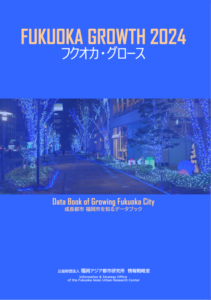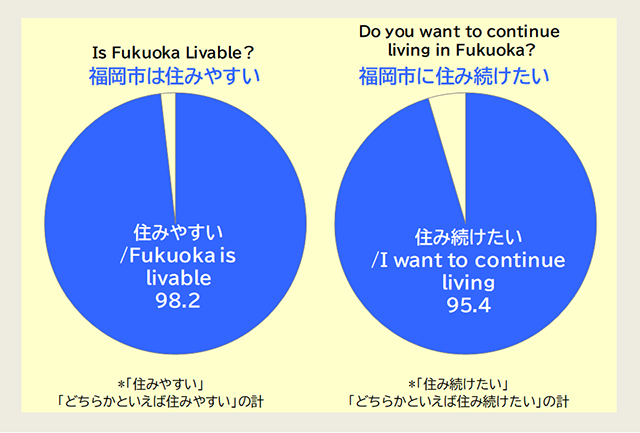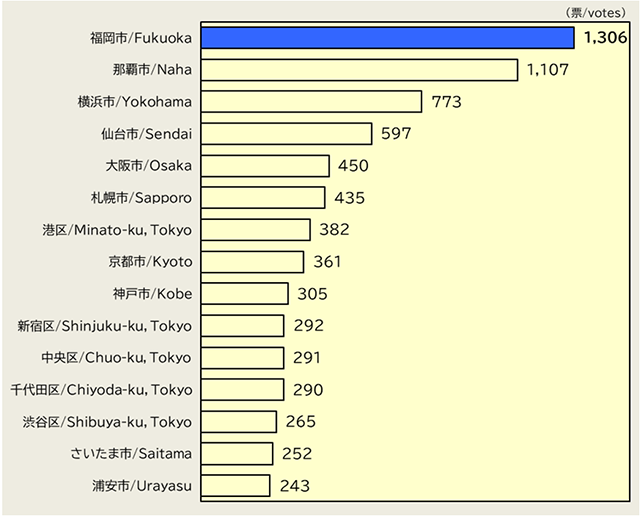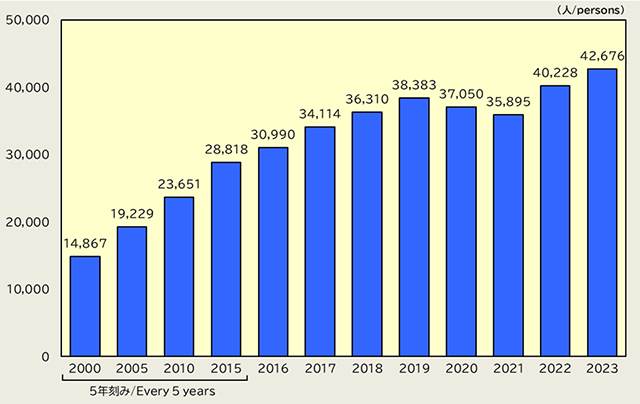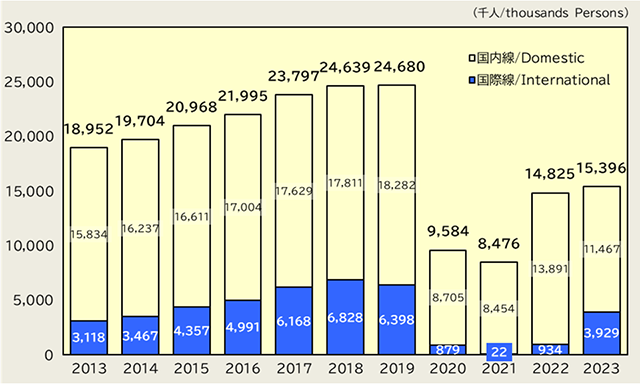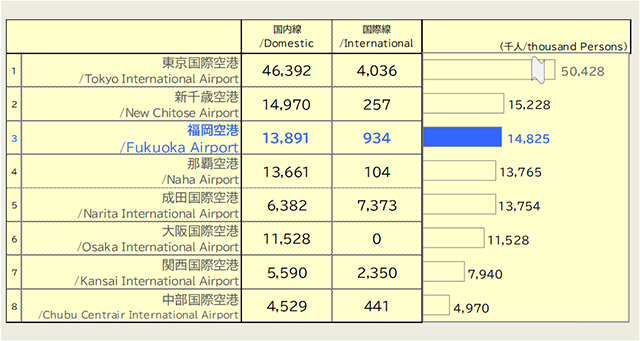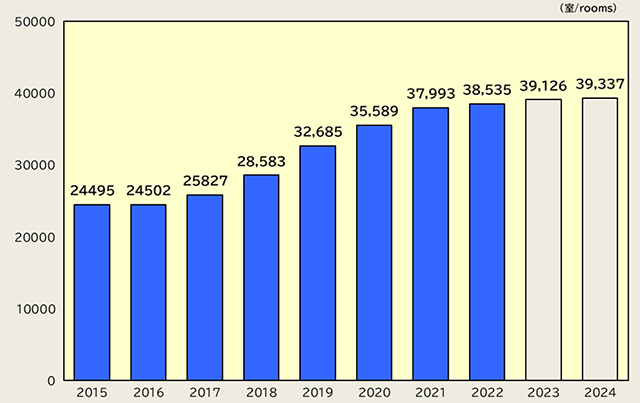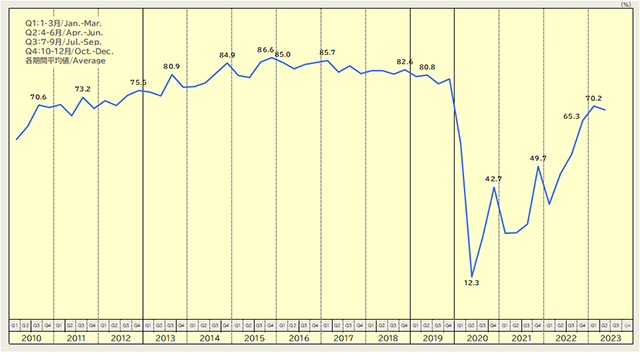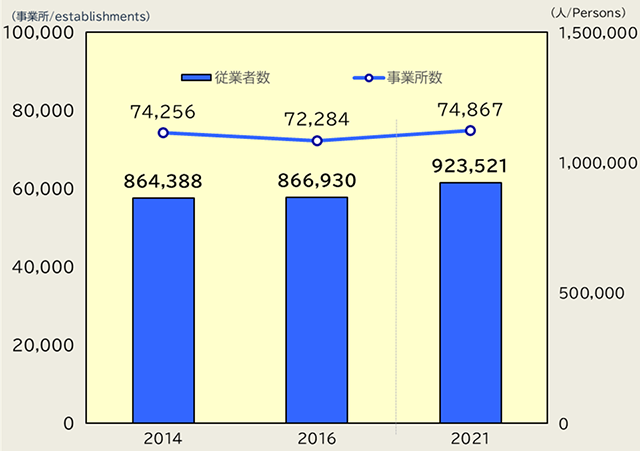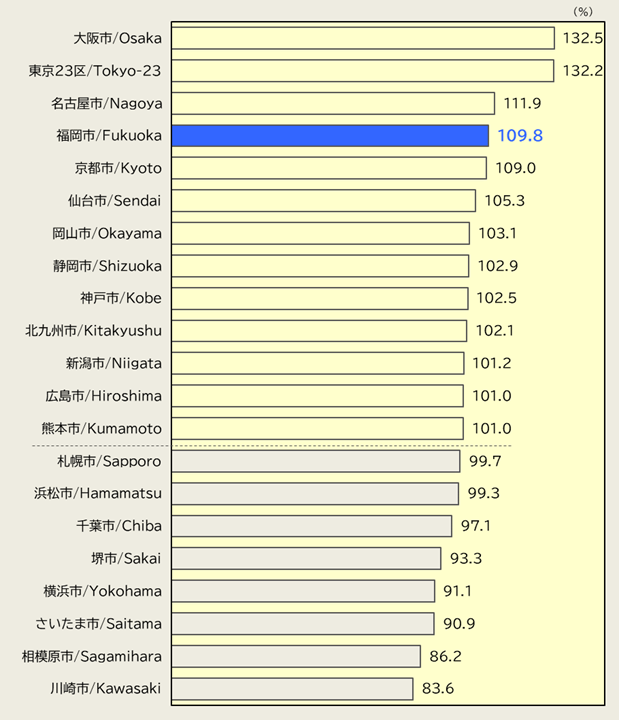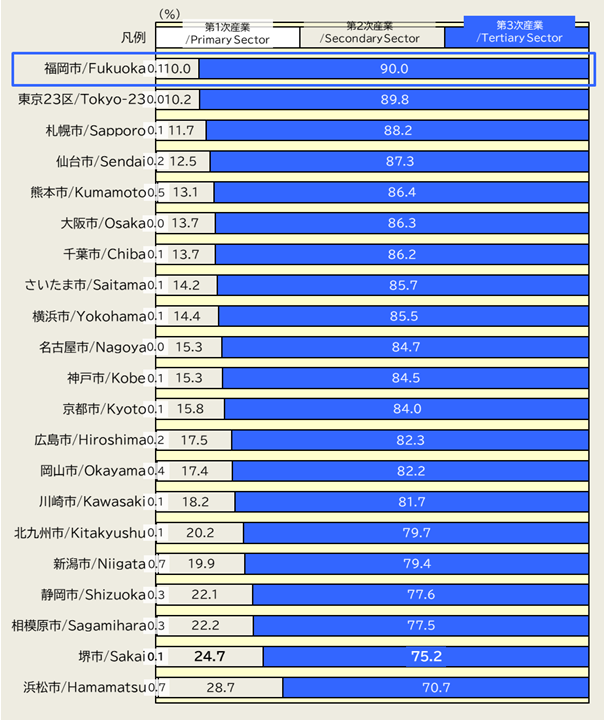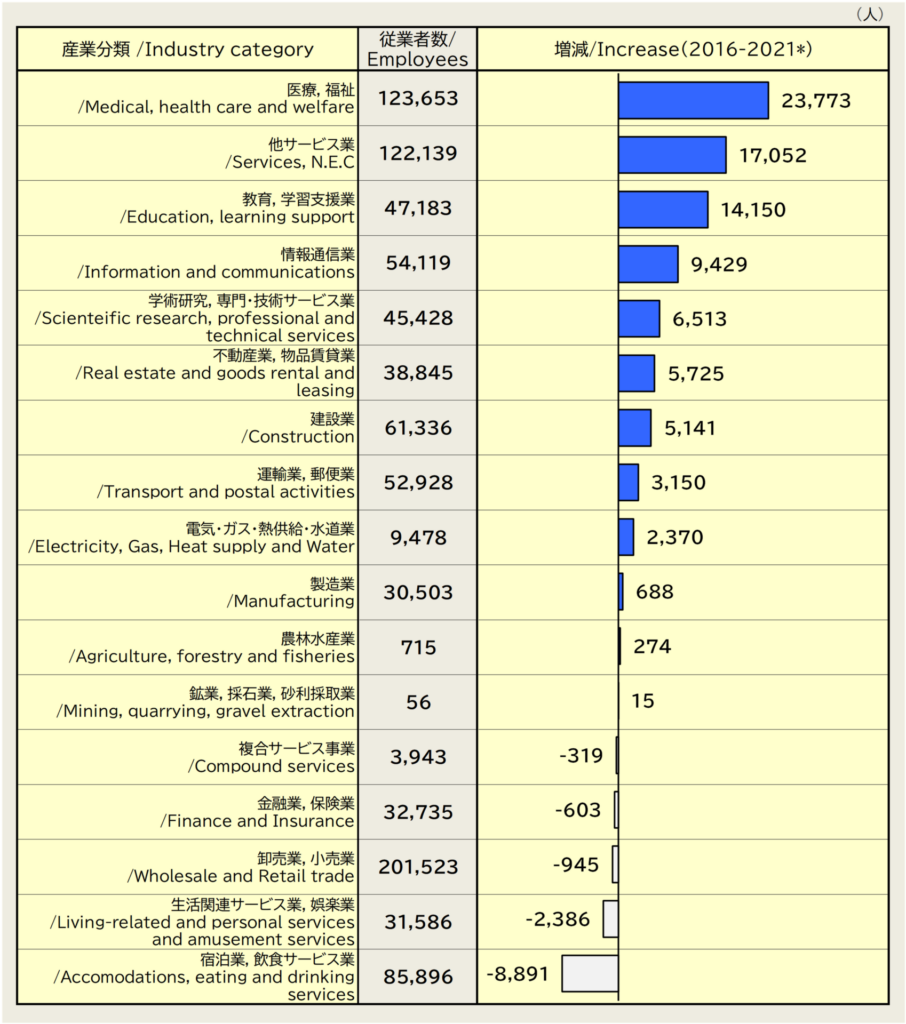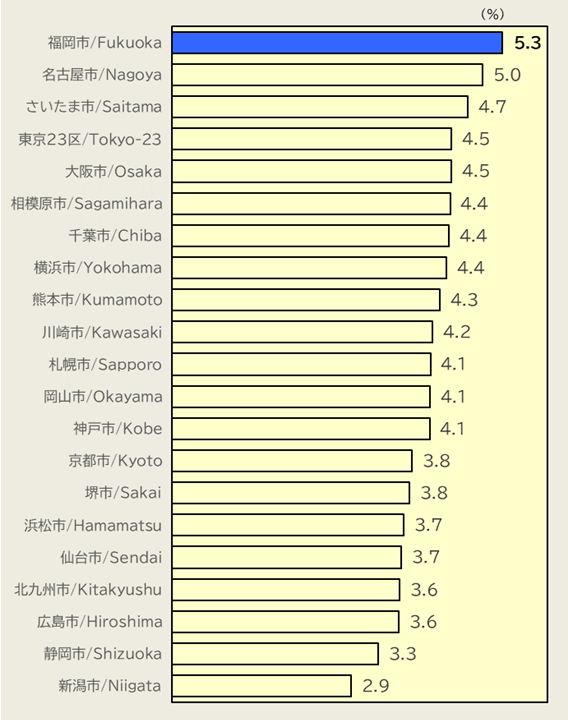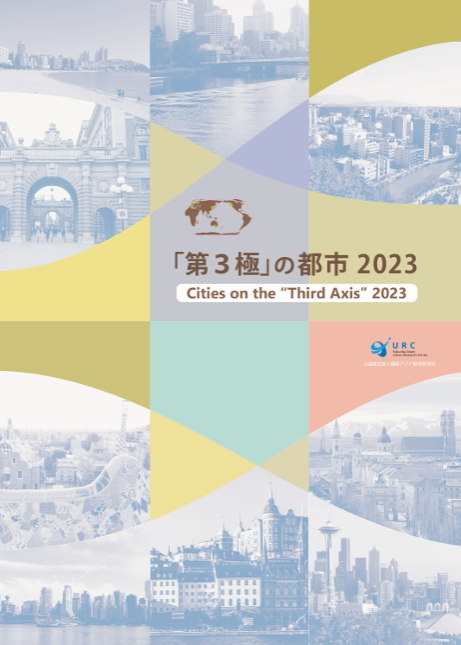
REPORT
刊行物・研究報告

刊行物
コラム
2024.05.20
『FUKUOKA GROWTH 2024』

【フクオカ グロース】 FUKUOKA GROWTH 2024
英語版・English⇒
「フクオカ・グロース」は、福岡市の成長性を示すさまざまなデータを紹介し、国内外の方とのビジネスや交流を促進することを目的に発行するデータブックです。
2014年以降、2022年までに計5回発行してきました。そして、10年目を迎える2024年春、シリーズの第6弾となる『FUKUOKA GROWTH 2024』を新たに発行いたしました。
このデータブックは、福岡市の成長性を、若い人材の集積、経済活動の進化、価値の集積といった視点でさまざまなデータをもとにわかりやすくご紹介しています。
|
『FUKUOKA GROWTH 2024』 |
ダウンロード |
|
| 発行日 | 2024年3月 | |
| 特徴 |
①わかりやすい図表 福岡市の成長指標や他都市との比較を視覚化 |
|
| ポイント |
生活の質の向上と都市の成長を示す指標を掲載 |
|
| 担当 | ● 畠山 尚久 ● 張睿 |
|
2023年秋にウェブ上で発信した「FUKUOKA GROWTH 2024」は、以下よりお読みいただけます。
福岡市は、さまざまな計画や市政運営の基本となる基本構想の中で、目指す都市像を「住みたい、行きたい、働きたい。 アジアの交流拠点都市」と掲げています。市民として住み続けたい。働き続けたい。市外の人も、住んでみたい。行ってみたい。働きたい。そんな、国内外の多くの人に選ばれる都市となることを目指しています。

出典:福岡市基本構想
福岡市に住みたい?
住みやすさは市民が実感 -過去最高更新!-
福岡市の「住みたい」について、まずは、市民アンケートの結果をみてみましょう。
福岡市が「住みやすいか」「福岡市に住み続けたいか」。いずれの質問も9割以上の人が肯定しています。
既に福岡市に住んでいる人は、住みやすく、このままずっと住みたいと考えていることがわかります(図表1)。
図表1 福岡市民の福岡市評価
資料:令和5年度市政に関する意識調査(福岡市)
最も住みたい都市・4年連続!
では、福岡市以外の人は、福岡市に住みたいでしょうか。
民間の不動産会社が行った全国規模のアンケート結果に、その答えが示されています。国内の「住みたい街」ランキングで、福岡市は全自治体の中で、堂々の1位です(図表2)。このアンケート調査は、自身が住むところを除いた回答なので、福岡市以外の人も、福岡市に住んでみたいと思う人がとても多いようです。しかも2020年の調査開始以降、福岡市は4年連続で1位に選ばれています。
福岡市民の多くが実感する住みやすさが、福岡市以外の人にも、じわじわと伝わり、浸透しているのかもしれません。
福岡市は、日本で一番住んでみたいです。
図表2 得票数上位都市
資料:街の住みここち & 住みたい街ランキング2023 <全国版>(大東建託株式会社)
*自身が住むところ以外で住みたい都市
福岡市は、国内だけでなく、海外からの移住者が増え続けています。
在住外国人の数は、コロナ禍で一時的に減少したものの、現在では回復し、40,000人を超えて、再び過去最高を更新し続けています(図表3)。
外国人も、福岡市に「住みたい」都市と考える人が、確実に増えています。
図表3 福岡市の在住外国人人口推移
資料:住民基本台帳(2011年以前は法務省外国人登録台帳)
福岡市に行きたい?
コロナ禍からの回復
2020年に始まったコロナ禍。それ以前は、福岡市を訪れる人は増え続け、福岡空港乗降客数は年間2500万人に迫るなど、過去最高を更新し続けていました。コロナ禍で大きく落ち込んだものの、世界的に人の移動制限が緩和される中で、福岡空港乗降客は、今年の8月時点でも急回復しつつあります(図表4)。
福岡空港乗降客数は、国内では3位です(図表5)。国内はもとより、アジアを中心とした数多くの国際便が運航しており、多くの人に、行きたい場所として選ばれています。
図表4 福岡空港乗降客数推移
資料:「空港管理状況調書」(国土交通省)
*2023年は8月時点までの速報値
図表5 国内空港乗降客数(上位のみ・2022年)
資料:「空港管理状況調書」(国土交通省)
福岡市を訪れる人が増加したことから、今も福岡市は多くのホテルが建設中です。コロナ禍にも関わらず、福岡市のホテル等客室数は増加を続けています(図表6)。「天神ビッグバン」「博多コネクティッド」などの都心部の開発計画でも、多くのホテルが計画されています。
ホテルの客室稼働率は、コロナ禍以前は、8割を超える非常に高い稼働率が続いていました。福岡市は、国際会議やスポーツ観戦、コンサートなどで一度に大勢の人が訪れる機会も多く、大きなイベント開催時には、予約が困難となる時期もありました。新型コロナウイルスの世界的な感染拡大で人の移動がストップした2020年には稼働率が大きく落ち込みましたが、移動制限が緩和された2023年には以前の水準へと急回復しています(図表7)。
図表6 福岡市のホテル等客室数の推移
資料:福岡市*2023年、2024年は計画含む見込み
図表7 福岡市のホテル客室稼働率推移
資料:宿泊旅行統計調査(観光庁)
*2023年は6月時点
福岡市で働きたい?
100万人近い労働力が集う都市
福岡市で働く人は、民間事業所だけで約92万人(図表8)、公的事業所まで含めると約97万人の人が福岡市で働いています。福岡市の総人口は、2020年は約161万人でしたが、周辺市町から福岡市に通勤・通学する人も多く、昼間人口は約177万人に膨れ上がり、昼夜間人口比率は109.8と、大阪市、東京23区、名古屋市の国内3大都市に次ぐ水準で、地方の大都市では最大です(図表9)。
福岡市は、就業面でも近隣地域の拠点都市となっています。
図表8 福岡市の事業所数・従業者数の推移
資料:経済センサス活動調査*民営のみ
*2021年の経済センサスは、従来から調査方法が変更されており、過去の数値は参考値として掲載
図表9 昼夜間人口比率【大都市比較】(2020)
資料:2020年国勢調査
*昼夜間人口比率:常住人口100人当たりの昼間人口の割合。100を超えると流出より流入の人口が多い。
時代に合わせた産業への変化
福岡市で働く人の約9割は第3次産業従業者です。21大都市の中で最も第3次産業の割合が高く、多くの人がサービス業に従事しています(図表10)。
産業分野別には、卸売業・小売業や医療・福祉業などが特に多くなっていますが、2016年からの増減(参考値)をみると、医療・福祉業のほか、情報通信業、学術研究、専門・技術サービス業などが増加しており、時代のニーズの変化に合わせて、福岡市で働く人の産業は変化していることがわかります(図表11)。
*2016年は調査方法が異なるため、2021年増減数は参考値。
図表10 従業者・産業構成比【大都市比較】(2021)
資料:令和3年経済センサス活動調査
図表11 福岡市の産業大分類別従業者数・増減数(2016-2021)
資料:経済センサス活動調査*民営事業者のみ
*2021年の経済センサスは、従来から調査方法が変更されており、過去の数値は参考値として掲載
福岡市は、起業を志す人の割合が高いのも特徴です。開業率は、21大都市圏の中で最も高くなっています(図表12)。福岡市では、新たな価値を創造するスタートアップを後押しするため、場官民共働型インキュベーション施設「Fukuoka Growth Next」を中心に、スタートアップの創業の裾野の拡大、成長支援を行っています。
時代とともに変化する分野から、次世代のワークスタイルへの挑戦まで、福岡市は多様な働き手が集まるまちです。
図表12 開業率【大都市地域比較】(2022)
資料:各都市の属する労働局(各大都市を含む地域の職業安定所別統計データをURCで調査収集・整理)
*職業安定所単位で当該大都市を含むエリアを合計しており、行政区域とは一致しない

